Drebrin-dependent actin clustering in dendritic filopodia governs synaptic targeting of postsynaptic density-95 and dendritic spine morphogenesis
- PMID: 12878700
- PMCID: PMC6740629
- DOI: 10.1523/JNEUROSCI.23-16-06586.2003
Drebrin-dependent actin clustering in dendritic filopodia governs synaptic targeting of postsynaptic density-95 and dendritic spine morphogenesis
Abstract
Dendritic spines have two major structural elements: postsynaptic densities (PSDs) and actin cytoskeletons. PSD proteins are proposed to regulate spine morphogenesis. However, other molecular mechanisms should govern spine morphogenesis, because the initiation of spine morphogenesis precedes the synaptic clustering of these proteins. Here, we show that synaptic clustering of drebrin, an actin-binding protein highly enriched in dendritic spines, governs spine morphogenesis. We immunocytochemically analyzed developing hippocampal neurons of low-density cultures. Filopodia-like dendritic protrusions were classified into two types: diffuse-type filopodia, which have diffuse distribution of drebrin, and cluster-type filopodia, which have drebrin clusters with filamentous actin (F-actin). Most cluster-type filopodia were synaptic filopodia. Postsynaptic drebrin clusters were found in both most synaptic filopodia and spines. Postsynaptic PSD-95 clusters, however, were found in only one-half of synaptic filopodia but in most spines. These data indicate that cluster-type filopodia are not mature spines but their precursors. Suppression of the upregulation of drebrin adult isoform (drebrin A) by antisense oligonucleotides against it attenuated synaptic clustering of PSD-95, as well as clustering of drebrin and F-actin. Furthermore, the restoration of drebrin A expression by injection of the expression vectors of drebrin A tagged with green fluorescent protein into the neurons treated with the antisense oligonucleotides induced synaptic reclustering of PSD-95 on clusters of the labeled drebrin A. These data indicated that the synaptic clustering of drebrin is necessary for that of PSD-95 in developing neurons. Together, these data suggest that synaptic clustering of drebrin is an essential step for spine morphogenesis.
Figures
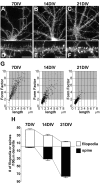

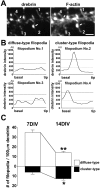

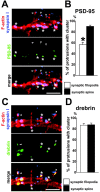
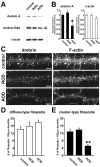
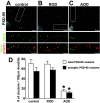
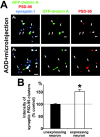
Similar articles
-
Overexpression of drebrin A in immature neurons induces the accumulation of F-actin and PSD-95 into dendritic filopodia, and the formation of large abnormal protrusions.Mol Cell Neurosci. 2005 Dec;30(4):630-8. Mol Cell Neurosci. 2005. PMID: 16456930
-
Activity of the AMPA receptor regulates drebrin stabilization in dendritic spine morphogenesis.J Cell Sci. 2009 Apr 15;122(Pt 8):1211-9. doi: 10.1242/jcs.043729. J Cell Sci. 2009. PMID: 19339553
-
Spine formation and correlated assembly of presynaptic and postsynaptic molecules.J Neurosci. 2001 Aug 15;21(16):6105-14. doi: 10.1523/JNEUROSCI.21-16-06105.2001. J Neurosci. 2001. PMID: 11487634 Free PMC article.
-
Making of a Synapse: Recurrent Roles of Drebrin A at Excitatory Synapses Throughout Life.Adv Exp Med Biol. 2017;1006:119-139. doi: 10.1007/978-4-431-56550-5_8. Adv Exp Med Biol. 2017. PMID: 28865018 Review.
-
Drebrin and Spine Formation.Adv Exp Med Biol. 2017;1006:157-181. doi: 10.1007/978-4-431-56550-5_10. Adv Exp Med Biol. 2017. PMID: 28865020 Review.
Cited by
-
The actin binding protein drebrin helps to protect against the development of seizure-like events in the entorhinal cortex.Sci Rep. 2021 Apr 21;11(1):8662. doi: 10.1038/s41598-021-87967-5. Sci Rep. 2021. PMID: 33883605 Free PMC article.
-
Hippocampal drebrin loss in mild cognitive impairment.Neurodegener Dis. 2012;10(1-4):216-9. doi: 10.1159/000333122. Epub 2012 Feb 4. Neurodegener Dis. 2012. PMID: 22310934 Free PMC article.
-
Drebrin, an actin-binding protein, is required for lens morphogenesis and growth.Dev Dyn. 2021 Nov;250(11):1600-1617. doi: 10.1002/dvdy.353. Epub 2021 May 6. Dev Dyn. 2021. PMID: 33896079 Free PMC article.
-
Docosahexaenoic acid protects from dendritic pathology in an Alzheimer's disease mouse model.Neuron. 2004 Sep 2;43(5):633-45. doi: 10.1016/j.neuron.2004.08.013. Neuron. 2004. PMID: 15339646 Free PMC article.
-
Dendritic spine formation and synapse maturation in transcription factor-induced human iPSC-derived neurons.iScience. 2023 Feb 27;26(4):106285. doi: 10.1016/j.isci.2023.106285. eCollection 2023 Apr 21. iScience. 2023. PMID: 37034988 Free PMC article.
References
-
- Asada H, Uyemura K, Shirao T ( 1994) Actin-binding protein, drebrin, accumulates in submembranous regions in parallel with neuronal differentiation. J Neurosci Res 38: 149-159. - PubMed
-
- Colicos MA, Collins BE, Sailor MJ, Goda Y ( 2001) Remodeling of synaptic actin induced by photoconductive stimulation. Cell 107: 605-616. - PubMed
Publication types
MeSH terms
Substances
LinkOut - more resources
Full Text Sources
Molecular Biology Databases
